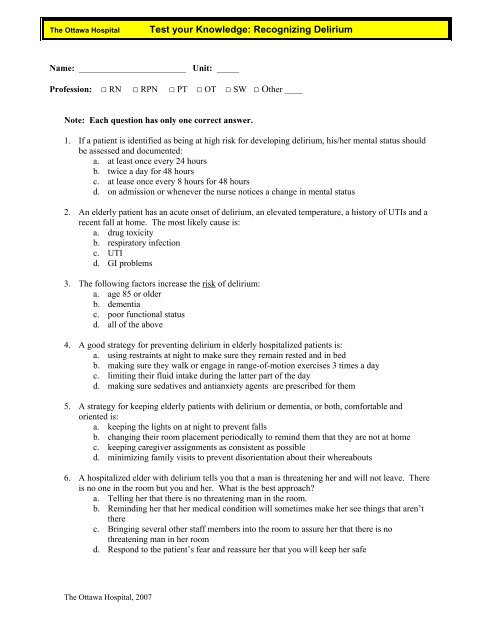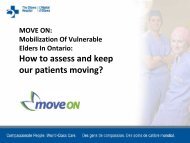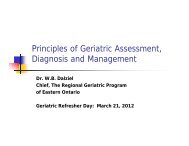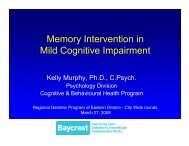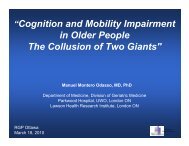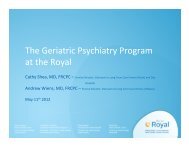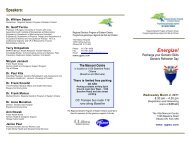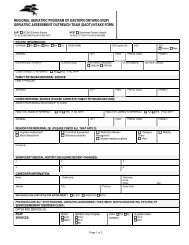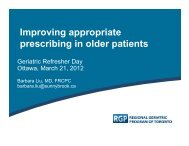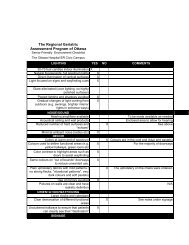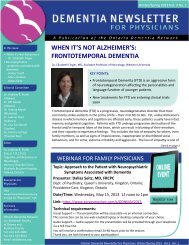Test your Knowledge: Recognizing Delirium
Test your Knowledge: Recognizing Delirium
Test your Knowledge: Recognizing Delirium
Create successful ePaper yourself
Turn your PDF publications into a flip-book with our unique Google optimized e-Paper software.
The Ottawa Hospital<br />
<strong>Test</strong> <strong>your</strong> <strong>Knowledge</strong>: <strong>Recognizing</strong> <strong>Delirium</strong><br />
Name: ________________________ Unit: _____<br />
Profession: □ RN □ RPN □ PT □ OT □ SW □ Other ____<br />
Note: Each question has only one correct answer.<br />
1. If a patient is identified as being at high risk for developing delirium, his/her mental status should<br />
be assessed and documented:<br />
a. at least once every 24 hours<br />
b. twice a day for 48 hours<br />
c. at lease once every 8 hours for 48 hours<br />
d. on admission or whenever the nurse notices a change in mental status<br />
2. An elderly patient has an acute onset of delirium, an elevated temperature, a history of UTIs and a<br />
recent fall at home. The most likely cause is:<br />
a. drug toxicity<br />
b. respiratory infection<br />
c. UTI<br />
d. GI problems<br />
3. The following factors increase the risk of delirium:<br />
a. age 85 or older<br />
b. dementia<br />
c. poor functional status<br />
d. all of the above<br />
4. A good strategy for preventing delirium in elderly hospitalized patients is:<br />
a. using restraints at night to make sure they remain rested and in bed<br />
b. making sure they walk or engage in range-of-motion exercises 3 times a day<br />
c. limiting their fluid intake during the latter part of the day<br />
d. making sure sedatives and antianxiety agents are prescribed for them<br />
5. A strategy for keeping elderly patients with delirium or dementia, or both, comfortable and<br />
oriented is:<br />
a. keeping the lights on at night to prevent falls<br />
b. changing their room placement periodically to remind them that they are not at home<br />
c. keeping caregiver assignments as consistent as possible<br />
d. minimizing family visits to prevent disorientation about their whereabouts<br />
6. A hospitalized elder with delirium tells you that a man is threatening her and will not leave. There<br />
is no one in the room but you and her. What is the best approach?<br />
a. Telling her that there is no threatening man in the room.<br />
b. Reminding her that her medical condition will sometimes make her see things that aren’t<br />
there<br />
c. Bringing several other staff members into the room to assure her that there is no<br />
threatening man in her room<br />
d. Respond to the patient’s fear and reassure her that you will keep her safe<br />
The Ottawa Hospital, 2007
The Ottawa Hospital<br />
<strong>Test</strong> <strong>your</strong> <strong>Knowledge</strong>: <strong>Recognizing</strong> <strong>Delirium</strong><br />
7. A key factor in differentiating delirium from depression and dementia is to consider the patient’s:<br />
a. mood<br />
b. sleep pattern<br />
c. psychomotor activity<br />
d. rapidity of onset of symptoms<br />
8. Using the Confusion Assessment Method (CAM), the diagnosis of delirium is likely in a patient<br />
who demonstrates:<br />
a. an acute onset, a fluctuating course, normal attention, disorganized thinking, and an<br />
altered level of consciousness<br />
b. an acute onset, a steady course, inattention, disorganized thinking, and an altered level of<br />
consciousness<br />
c. an acute onset, a fluctuating course, inattention, disorganized thinking and alertness<br />
d. an acute onset, a fluctuating course, inattention, disorganized thinking, and an altered level<br />
of consciousness<br />
9. When assessing elderly patients for delirium, drug toxicity or an adverse drug reaction is most<br />
likely when the patient:<br />
a. is taking a short course of antibiotics<br />
b. takes 5 or more medications<br />
c. has a history of constipation<br />
d. takes supplemental thyroid hormone<br />
10. A helpful technique for communicating with patients with delirium is to:<br />
a. speak gently & make all instructions as simple as possible<br />
b. avoid eye contact, because they may perceive it as a threat<br />
c. re-orientate with papers and examples because they can be very agitated<br />
d. speak loudly and clearly<br />
11. Planning care of a patient with delirium should include:<br />
a. removing calendars from the patient’s environment, because they can increase<br />
disorientation<br />
b. allowing family photos only if the patient can identify the people in them<br />
c. encouraging the patient to consistently use assistive devices like eyeglasses and hearing<br />
aids<br />
d. maximizing the patient’s exposure to environmental sounds, such as alarms, to remind the<br />
patient that he or she is in the hospital and not at home<br />
12. A helpful intervention for a patient with delirium and pain is to:<br />
a. administer scheduled or “around the clock” medications, rather than intermittent doses<br />
b. wake the patient often to offer PRN medications<br />
c. encourage the patient to tell you every time he/she is experiencing pain & to ring the bell<br />
d. place the patient’s mattress on the floor<br />
13. When a patient has been screened and identified with a possible delirium you can:<br />
a. place the CAM Risk Factor Alert on the chart<br />
b. place pre-printed physician’s orders on the chart for review<br />
c. target interventions to the underlying root causes<br />
d. teach patient and family using the patient teaching handout<br />
e. all of the above<br />
The Ottawa Hospital, 2007
Answers to <strong>Delirium</strong> Quiz<br />
Review Self-Directed Resource Guide for <strong>Delirium</strong><br />
LOOK, SCREEN & INTERVENE<br />
Questions Answer Where to find the answer in<br />
the Self-Directed<br />
1 D Chapter 3 & 6<br />
2 C Chapter 3<br />
3 D Chapter 3<br />
4 B Chapter 5<br />
5 C Chapter 5<br />
6 D Chapter 2 & 5<br />
7 D Chapter 2 & 6<br />
8 D Chapter 4 & 6<br />
9 B Chapter 3<br />
10 A Chapter 5<br />
11 C Chapter 5<br />
12 A Chapter 5<br />
13 E Chapter 6<br />
The Ottawa Hospital, 2007
The Ottawa Hospital.<br />
<strong>Test</strong> <strong>your</strong> <strong>Knowledge</strong>: <strong>Recognizing</strong> <strong>Delirium</strong><br />
Quiz Answers with Rationales.<br />
1. Chapter 3, page 10; Chapter 6, page 27<br />
d. The Policy & Procedure states that a patient’s mental status should be assessed on<br />
admission and whenever a change is noticed. Knowing a patient’s baseline cognitive<br />
status is key to recognizing that a change has occurred.<br />
2. Chapter 3, page 10<br />
c. A UTI is often asymptomatic except for a new onset of falls and delirium.<br />
3. Chapter 3, page 10<br />
d. Advanced age, pre-existing cognitive deficits and poor functional status have all<br />
been found to be factors associated with the development of delirium.<br />
4. Chapter 5, page 23<br />
b. Encouraging mobility helps to improve strength and prevent the deconditioning and<br />
other complications which may contribute to the development of delirium<br />
5. Chapter 5, pages 23<br />
c. Consistency in the caregiver benefits the patient whose short term memory may be<br />
affected; it also helps the staff get to know the patient better. In addition, it promotes<br />
the setting of a consistent care routine which has been shown to decrease anxiety.<br />
6. Chapter 2, page 7<br />
d. Hallucinations may be very real to delirious patients; reassurance that they will be<br />
safe may be the best intervention during the acute phase.<br />
7. Chapter 2, page 6; Chapter 6, page 31<br />
d. A key difference in determining that a patient is delirious is the abrupt onset of<br />
symptoms (from hours to days). Dementia and depression tend to have a more gradual<br />
onset.<br />
8. Chapter 2, page 7; Chapter 4, page 18; Chapter 6, page 27<br />
d. As per the Confusion Assessment Method, for a delirium to exist, the patient must<br />
demonstrate both an acute onset, inattention, and either / or disorganized thinking or<br />
an altered level of consciousness.<br />
The Ottawa Hospital, 2007
The Ottawa Hospital.<br />
<strong>Test</strong> <strong>your</strong> <strong>Knowledge</strong>: <strong>Recognizing</strong> <strong>Delirium</strong><br />
9. Chapter 3, page 11<br />
b. Evidence suggests that drug toxicity and adverse drug reactions are more likely to<br />
occur when an older patient is taking 5 or more medications.<br />
10. Chapter 5, pages 23 - 24<br />
a. Keep instructions simple by only asking for one thing at a time. Delirious patients<br />
may not be able to remember multiple instructions.<br />
11. Chapter 5, pages 23 -24<br />
c. Sensory deprivation will contribute to delirium. Patients may misinterpret sensory<br />
stimuli in the environment if they cannot see or hear. Evidence supports ensuring the<br />
patient uses all assistive devices such as glasses and hearing aids or amplifiers.<br />
12. Chapter 5, pages 23 - 24<br />
a. Research has shown that around the clock analgesia is more effective than PRN by<br />
maintaining a steady blood level.<br />
13. Chapter 6, page 26 - 28<br />
e. All elements are part of the Policy & Procedure, intended as ways to enhance care<br />
of the delirious patient. Clinical units may choose whether or not to use the Pre-<br />
Printed orders based on their particular needs. Consistency is essential in<br />
communicating delirium risk, symptoms, interventions and their effectiveness.<br />
The Ottawa Hospital, 2007


